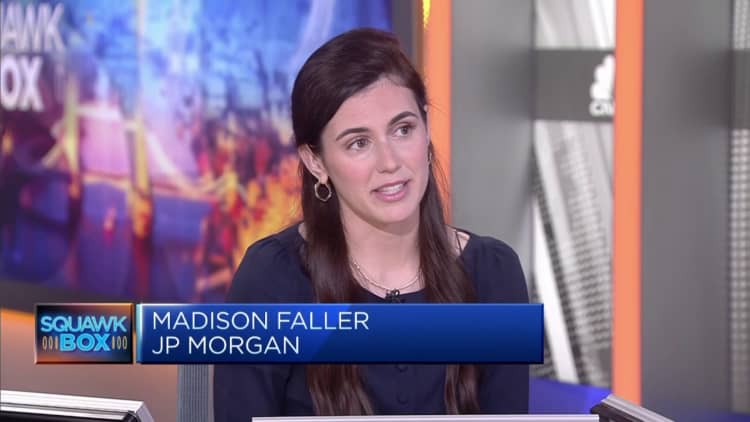

The Federal Reserve announced Wednesday that it will leave interest rates unchanged as inflation continues to prove higher than expected.
However, the move also dashes hopes that the Fed will be able to soon begin cutting rates and relieving consumers from exorbitant borrowing costs.
The market is now pricing in a rate cut later in the year, according to the CME’s FedWatch measure of futures market prices. At the start of 2024, at least six reductions were expected, which was “completely fantasy territory,” said Greg McBride, chief financial analyst at Bankrate.com.
This change in rate cut expectations leaves many households in a bind, he said. “Certainly, from a fiscal perspective, not only does inflation remain high, but that’s on top of the cumulative increase in prices over the past three years.”
“Prioritizing debt repayment, especially high-cost credit card debt, remains paramount as interest rates promise to remain high for some time,” McBride said.
Learn more about personal finance:
Savers still have a chance to beat inflation
Here’s What’s Wrong With TikTok’s Viral Savings Challenges
Strong U.S. labor market in ‘sweet spot,’ economists say
Inflation has been a persistent problem since the Covid-19 pandemic, when price increases reached their highest levels since the early 1980s. The Fed responded with a series of interest rate hikes that brought its reference rate at its highest level in more than 22 years.
The federal funds rate, set by the U.S. central bank, is the rate at which banks borrow and lend to each other on a daily basis. Even though it’s not the rate consumers pay, the Fed’s actions still affect the borrowing and saving rates they see every day.
Rising interest rates have caused most consumer borrowing costs to skyrocket, putting many households under pressure.
Rising inflation has also been bad news for wage growth, as the real average hourly wage has increased only 0.6% over the past year, according to the department’s Bureau of Labor Statistics work.
Even with possible rate cuts on the horizon, consumers won’t see their borrowing costs drop significantly, according to Brett House, an economics professor at Columbia Business School.
“Once the Fed cuts rates, that could flow through to other rates, but there’s no guarantee necessarily,” he said.
From credit cards and mortgage rates to auto loans and savings accounts, here’s a look at where these rates could go in the second half of 2024.
Credit card
Since most credit cards have a variable rate, there is a direct link to the Fed’s benchmark. As a result of the rate hike cycle, the average credit card rate has increased from 16.34% in March 2022 to nearly 21% today, an all-time high.
Annual percentage rates will start to fall when the central bank cuts rates, but even then they will only fall from extremely high levels. With only a few potential quarter-point reductions, APRs aren’t expected to drop much, according to Matt Schulz, chief credit analyst at LendingTree.
“If Americans want lower interest rates, they will have to do it themselves,” he said. Try calling your card issuer to ask for a lower rate, consolidating and paying off high-interest credit cards with a lower-interest personal loan or switching to a balance transfer credit card uninteresting, Schulz advised.
Mortgage Rates
Even though 15- and 30-year mortgage rates are fixed and linked to Treasury yields and the economy, anyone purchasing a new home loses considerable purchasing power, in part due to inflation and policy measures. the Fed.
The average rate for a 30-year fixed-rate mortgage is just above 7.3%, up from 4.4% when the Fed began raising rates in March 2022 and 3.27% at the end of 2021. according to Bankrate.
“Going forward, mortgage rates will likely continue to fluctuate and it’s impossible to say with certainty where they will end up,” noted Jacob Channel, senior economist at LendingTree. “That said, there’s a good chance we’ll have to get used to rates above 7% again, at least until we start getting better economic news.”
Auto Loans
Even though auto loans are fixed, payments are increasing because car prices have risen along with interest rates on new loans, making monthly payments less affordable.
The average rate on a five-year new car loan is now above 7%, up from 4% in March 2022, according to Edmunds. However, competition among lenders and increased market incentives have recently begun to reduce the cost of buying a car, said Ivan Drury, chief research officer at Edmunds.
“Any reduction in rates will be particularly welcome as there is a growing share of consumers with older trade-in vehicles who have sat out the market madness while waiting for an automotive landscape that looks more like it did last time. “They bought a vehicle six or seven years ago,” Drury said.
Student Loans
Federal student loan rates are also fixed, so most borrowers are not immediately affected. But undergraduates who took out federal direct student loans for the 2023-2024 academic year now pay 5.50%, compared to 4.99% in 2022-2023 – and any loans disbursed after July 1 will likely still be higher. Interest rates for the next school year will be based on an auction of 10-year Treasury notes later this month.
Private student loans tend to have a variable rate tied to prime, T-bills, or another rate index, meaning these borrowers are already paying more interest. However, the additional amount varies depending on the benchmark.
For those struggling with existing debt, there are ways for federal borrowers to reduce their burden, including income-driven plans with $0 monthly payments and unemployment and economic hardship deferrals.
Private borrowers have fewer relief options – although some might consider refinancing once rates start to fall, and those with better credit might already qualify for a lower rate.
Savings rate
Although the central bank has no direct influence on deposit rates, returns tend to be correlated with changes in the federal funds target rate.
As a result, rates on high-yield online savings accounts have seen significant changes and are now yielding over 5.5%, above the rate of inflation, which is a rare victory for anyone building a cash reserve, McBride said.
“The mantra of higher, longer interest rates is music to the ears of savers who will continue to enjoy inflation-beating returns on safe haven savings accounts, money markets and CDs for the foreseeable future” , did he declare.
Currently, high-yield certificates of deposit pay more than 5.5%, which is as good as or better than a high-yield savings account.
Subscribe to CNBC on YouTube.
cnbc





